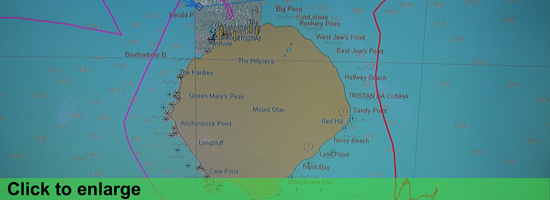
SET EXPO 2017 - What was discussed?
SET Expo 2017 - What was discussed?
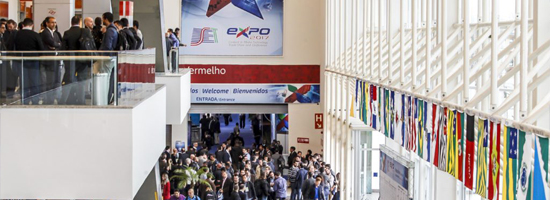
From August 21 to August 24, SET EXPO 2017 presented and discussed technical innovations, regulations and new products in the audiovisual market, covering the entire production chain, from creation through to distribution. At the Congress, the participants discussed how to manage, produce, transmit and distribute multimedia electronic content while debating the current standards and regulations, with the emphasis on the current and future scenario for telecommunications. At the Trade Show, the main domestic and international manufacturers showcased their products to an audience representing the entire audiovisual and broadcasting production chain.
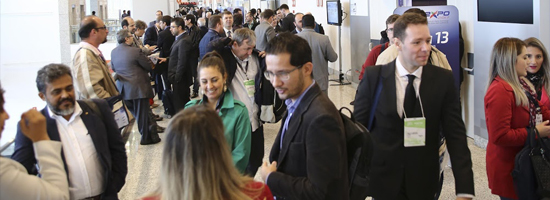
There were many points discussed this year, and the 14 main ones were:
New TV standards, UHD formats and next steps
Kenizhi Murayama, NHK senior researcher, gave an overview of the digital broadcasting service in Japan and the 8K signal, tested on major broadcasts in the country since 2015 (in that year, there was a transmission test, in 2016 a new test was made during the Olympic Games in Rio, and the next one will take place during the World Cup in Russia in 2018, and finally the model of transmission to be adopted for the Tokyo Olympics in 2020). NHK began testing the system on domestic broadcasts last year. And the test of transmission done in Rio last year, in partnership with TV Globo, is the same that we implemented later in Japan.
Another good news is about ATSC 3.0, the groundbreaking standard of terrestrial television broadcasting, that is almost ready, which increases the channel capacity by 30% with improvements in audio and video quality, with multiple audio and video streams, custom content, a wider choice of consumer and transmitter choices, internet interactivity, advanced emergencies and new alerts accessibility features.
There was also discussion about the next steps of the TV based on mobile devices, looking at the total view time for videos growing with the massive growth of views on mobile devices.
Another discussion is about new technologies and trends that could help reduce the compression rates for transmission, on the support of different formats of HDR and transmission networks for the distribution of 4K/8K signals.
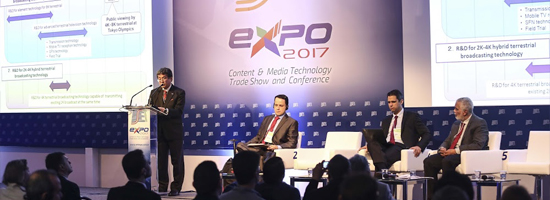
Digital revolution and the new doors that are opening
According to the presentation of the Google executive, Fábio Coelho, the TV set is still the main screen, but its use has stopped growing. By 2015, in the United States, for example, 60% of millennials (born between the mid-1980s and the 2000s) still preferred television, but 26% opted for a computer screen. Mobile gadgets were 14% of preference. By comparison, TV is the choice of 79% of the generation X (born between 1960 and the early 1980s), and 86% of baby boomers born during the post-World War II and 1960s.
Advertising revenue reflects this change and therefore "we should think about video rather than television," Coelho reflected, "and our role is precisely to help companies generate value in the digital economy. The human being remains the same, but today we have very different expectations. The consumer is much more impatient and lazy, and companies need to understand what role they play in reducing that friction." As examples within the company, the executive has shown that Brazil is one of the top five Google countries in the use of platforms and that Waze has Sao Paulo as the main city.
Also, Liliana Nakonechnyi, the president of SET - organizing entity of SET EXPO, analyzed the Brazilian trajectory of the analog TV system until the implementation of the Brazilian digital TV technology (ISDB-TB), created from the Japanese standard. She also said: "We have had a leading role in this movement, but the technology also throws uncertainties on how to adopt tools like IP for video, cloud usage, and other changes."
Masahiko Tominaga, representing Japan's contribution to the deployment of digital TV in Brazil, believes that "success in shutting down the analogue signal in cities as big as São Paulo is an important motivation for other cities in Brazil. Last year, was the celebration of 10 years of ISDB-TB, in 2017 El Salvador also joined this group of 19 countries. This signal pattern was adopted in almost all the countries of South America and Central America in Guatemala, Honduras, Nicaragua and Costa Rica.
More flexibility and scalability: IP in broadcasting
The IP expert at Grass Valley, Robert Erickson, hosted the IP Production: From Theory to Practice workshop, which took place on the afternoon of last Monday, August 21, during the SET Congress. According to the executive, the industry is changing and new forms of consumption are demanding adjustments in the production and distribution chain and business models.
"The means of distribution are very diverse and each requires an image resolution," he says, noting that removing the physical interfaces of the equation allows the construction of more modern solutions that meet modern workflow requirements.
IP can reduce operating costs and provides gains in scalability, flexibility and upgradeability, and broadcast industry is headed for that. And this change will take a while.
Claudio Szabas, the company's project manager, followed a demonstration of Grass Valley IP solutions, noting that there are no changes to the operator, which uses the panel that is already used, and can direct the camera, the IPG and share the multiviewer.
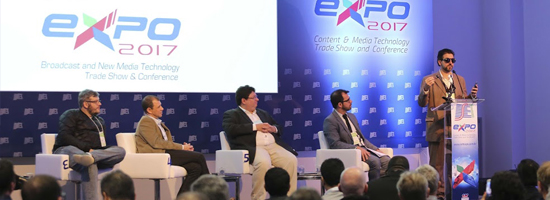
Virtual reality: closer than you think
Many still do not know, and believe that virtual reality is a fad, and others believe it is a trend. Marcos Alves, director of ventures of the Canadian YDreams Global; Renato Citrini, Senior Product Manager, Samsung Mobile Devices Division; and Ricardo Laganaro, director of O2 Filmes, were invited to discuss the issue in the panel on Innovation and Disruptive Technologies that took place on the afternoon of Monday, August 21, during the SET Congress. For them, the cheapening of the equipment, the improvement in the quality of connection to the internet and also of the production must help the virtual reality to reach the masses.
According to Citrini, Samsung has worked to perfect and at the same time cheapen its line of glasses for VR. The latest version of Gear VR comes with a control, the camera is smaller, has more functionality, such as the ability to do live streaming, and is cheaper. "Things evolve at an amazing speed. Anyone can be a virtual reality producer and consumer." The manufacturer has made some bets to increase the consumption of the technology, like transmission of fights of UFC with cameras positioned in the border of the octagon or transmission of shows, one of the most recent one was of the band Coldplay in the United States. Locally there are also some initiatives to increase the offer in the Samsung VR content store.
For Alves, the great opportunities for the diffusion of the virtual reality are the independent games, the arcades of virtual reality, the platforms of distribution and capture of contents, like the NextVR, the possibilities in the areas of education, health and in the industry of the sex. As a content producer, Laganaro is also committed to the development of technology and fast consumer acceptance. "I prefer to speak in immersive narratives," says the director, remembering that those who produce content need to start thinking beyond the flat screen, to learn a new way of operating in the audiovisual, because to produce using virtual reality is a cyclical process involving content, technology, production, narrative and language.
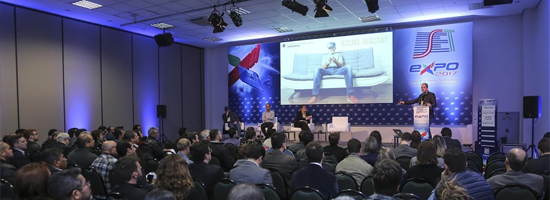
IoT: digital security
Brazil is the fourth country in terms of DDoS-type cyber attacks, in which servers are not properly invaded, but are prevented from functioning. The number is a good index to assess the importance of security for content production and broadcasting companies, an issue explored by experts during the first day of the SET EXPO 2017 Technology Congress.
One of the big doors to the threats are Internet-connected devices, such as smart TVs and mobile phones, which are expected to add up to 20 billion handsets by 2020, according to TV Globo's information security expert Leandro Valente. Often the danger is easy to avoid, as many devices such as security cameras and internet routers have the default password maintained by users. The key is to change the settings at the time of installation. In a universe in which every audiovisual work is available mainly in digital media, companies must also be attentive to their internal processes. 9 out of 10 companies in the country suffer from cybersecurity violations, said Tácito Leite, director of T-Risk. "The Internet of Things is the new frontier for cyber-extortion, but companies do not consider security as a fundamental requirement."
Startups: new technologies and opportunities
With gaps for new companies, new entrepreneurs, the market for audiovisual innovation can be a great opportunity for growth. Most audiovisual productions are still concentrated in traditional media, but lower-cost productions are gaining ground, as the public's attention is drawing.
Today it is possible to capture aerial images at a lower cost through drones, cameras and equipment are more accessible. For example, 360-degree content and integration with OTTs make content profitable, showing that a good idea is enough to become a big business.
"More than money, startups need business opportunities," said Edson Mackeenzy, head of the SET Innovation Zone, a pavilion designed to give visibility to startups working in the audiovisual industry during SET EXPO. "Companies need to invest and believe in national technology."
Also, the president of Abragames and CEO of Webcore Games, Fernando Chamis, addressed the gaming market in Brazil and the world, and gave examples of games made in the country that today are successful worldwide, such as Horizon Chase. "It's a market that has been growing, for a long time, 10% a year," he said. In Latin America, Brazil is the market that makes the most, although the number is still low, due to cost and piracy.
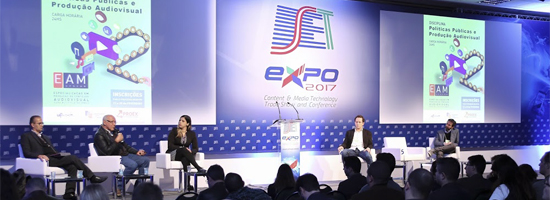
SET EXPO 2017: Business and optimism
The mission of SET EXPO 2017 is to stimulate discussions and offer the solutions to foster the changes of the industry in Brazil towards digital convergence. And the expectation of the exhibitors is that the event move more than $ 40 million in business.
The main point was the convergence of Telecom companies, pay-TV operators, large and independent producers, the advertising market and even youtubers.
In addition, the video market is diversifying and presents several options, highlighting 4K, HDR, IP technologies, all new workflows and formats.
The Technology Congress brought together 1400 congress members in four days of panels with experts from companies such as TV Globo, O2 Filmes, Dolby Laboratories, SBT, RecordTV, Ericsson, Samsung, and more than 40 entities, such as SEBRAE - Brazilian Service of Support to Micro and Small Enterprises; ABRATEL - Brazilian Radio and Television Association; ABERT - Brazilian Association of Radio and Television Broadcasters; AESP - Association of Radio and Television Broadcasters of the State of São Paulo, among others.
Cloud Storage trend
Digital transformation in the industry has changed the way suppliers and broadcasters think and market their experiences and products.
The demand for OTT video services is growing, and since then the budget for cloud services has been following this trend. One of the concerns when it comes to the subject is the security issue.
There is no doubt that the cloud will continue to be a storage trend and that the market dynamics have brought several issues for the companies that use the service, since there must be agile, fast and economical systems. It is worth mentioning that the use of the cloud is not only for end users, but for several sectors, such as the journalistic, in social networks, in post-production.
UHD and Digital Cinema
The innovations and disruptive technologies point to ongoing transformations that encompass audiovisual productions in multiple screens and windows. In the stations there is the expectation of the arrival of the 4K, something that already is reality in the cinema.
In addition, there are many goals in a fully digital environment, especially in post-production, in process planning, always ensuring maximum quality.
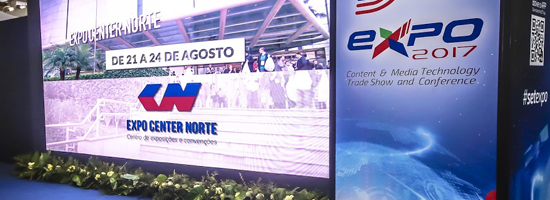
IP and Satellites
Satellite industry is going through a very special moment, not only from an application point of view, but also from a technology standpoint. And consumer behavior dictates the need for new IP technologies.
With the IP universe, new applications will have room for video and audio. The trend is that satellite companies become IP video companies, even if it is a conservative market, changes are expected to occur more and more.
Switch-off: Lessons and what’s around
The switch-off in Brazil has worked well and every city that enters the digital age there is a new learning. The instruction of the population and the installation of adapters has had a positive return, even if at the beginning they had a concern with the distributed kits.
One of the concerns was the audience issue, whether the transition would cause the audience to fall due to signal change, but studies showed that there were no changes.
In addition to the concerns, it is relevant to say that the market has grown as people began investing in new TVs.
Digital era: Real experiences and audience
Engaging consumers with experiences is the best way to ensure audience in the entertainment market.
The phrase that sums up the new consumer mode of media is: Unique experience. The idea is to bring people on different platforms to the same point, in order to establish a relationship, loyalty to the client using the convenience of digital and preserving the best in the face-to-face experience.
The trend can be seen through data, according to research conducted by Marcela Doria, director of research for Twitter in Latin America, 9 out of 10 people declare that the smartphone is the most used device to access the Internet, and 7 out of 10 multiteels are declared. That is, many people use the smartphones while watching television, for example. In Brazil alone, more than 1 million tweets per day are related to TV. Twitter today is the smallest distance between the viewer and the content, and the tool is able to contribute about 13% to the audience of a show, with even greater force in live events such as the Oscars.
OTT in Brazil and worldwide
According to the research presented by Salustiano Fagundes, founder of HIRIX Engenharia de Sistemas and CEO of HXD Smart Solutions, the OTT market will reach US$ 64 billion worldwide in 2021, with US $ 3.59 billion being only between Brazil and Mexico, who should lead Latin America and occupy, respectively, the fourth and fifth global posts. As for the survey conducted in the United States, consumers spend 45% more time choosing what to watch on VOD services than looking for a program to watch on linear TV, and 4K video streaming is growing, with Netflix and Amazon broadcasting on that quality.
Meanwhile, NHK's senior research engineer, Masaru Takechi, who works to deploy and harmonize the Hybridcast, a second-screen and VOD/streaming service said that in Japan, more than five million people use the system, with flexible selection of content, generating targeted advertising and a similar content relation.
The director of digital platforms Globo.com, Marcello Azambuja, talked about the live streaming company. The first was the Big Brother Brazil and in 2003, the first OTT of Brazil was launched, the Globo Media Center, and in 2005 it had the broadcast of the NBA final. In 2010, at the World Cup, the site made the broadcast for the first time in HD. And in 2014 had the first multi-camera live stream. He complements saying about the availability of 4K content available on Globo Play.
Migration of AM radios
Radio is one of the most accessible and popular media worldwide, and the migration of AM to FM broadcasters has moved companies and regulators in Brazil.
RBS project manager, Cauê Franzon, showed that conventional radio is still 58% of the audience between 10am and 11am, and 15% of cellphone listeners between 2pm and 3pm. Only 5% listen through the computer between 2pm and 3pm. The data compiled by Ibope show that radio reaches 89% of people in the 13 metropolitan regions where the audience is measured, which is equivalent to 52 million people. The average time of the tuned is of 4h36, which shows a space of great growth in mobile devices.
The great effort needed to accommodate the stations that will migrate from AM to FM is much discussed, and we are likely to see more discussions about it, to make the switch as smooth as the switch-off is on TV in Brazil.
If you want to see how the fair was, visit the link.
In this video you can view some of SET Expo 2017:
We would like to thank Marcel Almeida for writing for us.
More info you can find on his LinkedIn: br.linkedin.com/in/marcelmg77/en or follow him on Twitter @marcelmg77
Like us if you want on Facebook, follow us on Twitter and Subscribe to our YouTube channel.
mentioned:
SET EXPO 2017 : Website - facebook - Twitter - YouTube
SET : Website
SET EXPO 2016
SET Expo 2016
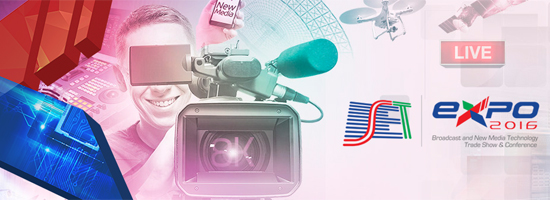
One of the major events in the broadcasting and new media sectors of the year took place at Expo Center Norte, SET EXPO 2016, in the Exhibition Hall Red, São Paulo (SP). With Conference: 08/29 to 09/01 and Trade show: 08/30 to 09/01.
Organized by SET (Sociedade Brasileira de Engenharia de Televisão), a not-for-profit technical association consisting of technology and operating companies and professionals and whose main purpose is the development of technical knowledge throughout the entire electronic media supply chain, from production to delivery. In Brazil, it represents the largest discussion forum on market standards and trends for the creation, management and distribution of electronic content.
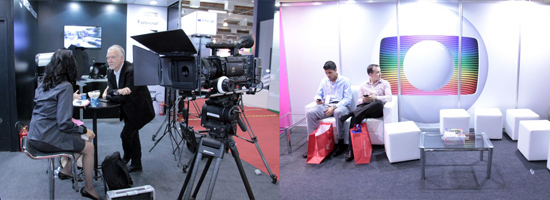
The event will host the major manufacturers on the global market; executives and technical personnel, specialists as well as researchers from government bodies, plus the press, technology, entertainment and broadcast sectors.
Last year, in its 27th edition, 15.900 participants attended the 5-day event, with the presence of 2.040 conference delegates, 150 members of the press, 5 international pavilions, 192 exhibitors, 8.000 m² net exhibition area and more than 400 exhibitor brands.
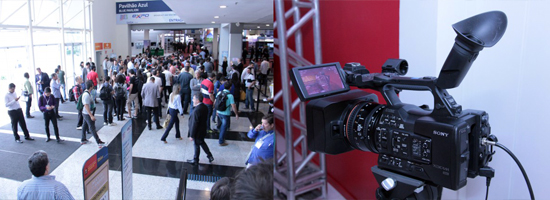
The event, this year, will had an exhibition area of 15.000 m², housing the stands of benchmark companies in the equipment, technology and services sector of the broadcast, telecommunications, audiovisual and new media market. This area will consist of thematic and international pavilions, made it easier for visitors to find their way around.
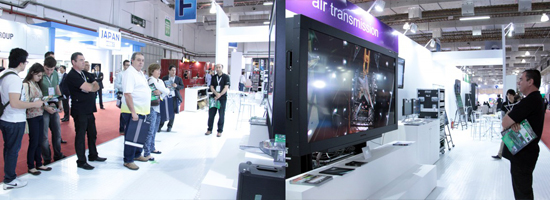
A program to support startups that create solutions for the entertainment industry, such as audiovisual producers, radio and television broadcasters, the cinema and new media will be at SET EXPO 2016, and it is called SET Innovation Zone.
SET Innovation Zone program had two stages: the public call, with free and open registration, and the presentation of the solution at SET EXPO 2016. And the 10 companies selected will receive a standard exhibition stand, already assembled, within the Innovation Pavilion of the trade show, and did showcase themselves, completely free! This was a unique opportunity for companies in the initial set-up phase. If you have any interest, it is worth taking a look at for more information.
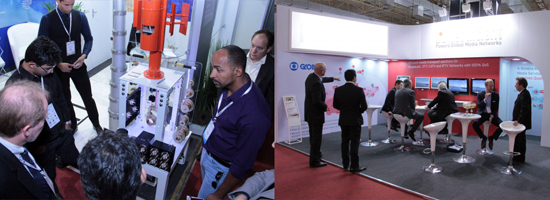
The topics to be discussed during the Congress were:
August 29, 2016: Distribution, Exhibition & Transmission: TVD – Analog Switch Off, Automation; Internet & TV: Sensoring & Big Data, Content On-line, OTTs & APPs – Current scenario of OTT services, Projects And Professional Profile; Hot Session: The Future of free-to-air Television; Innovation & Disruptive Technologies: VR – “Will Virtual Reality be the most social platform of all?”; Infrastructure: Energy - Quality and Efficiency; Research & Development: Vision of communicators regarding to the future of broadcasting and new media; Regulatory & Norms: EAD – Be Digital - The Rio Verde (GO) pilot experiment, preparations for Brasília and São Paulo and projections for Brazil; Innovation & Disruptive Technologies: Drones; Consumption: Connected TVs and interactivity.
August 30, 2016: Opening & Commemoration: Opening Ceremony SET EXPO 2016 & ISDB-T 10 years celebration; Trade Show SET EXPO 2016: Inauguration Fair SET EXPO 2016 – RED Pavilion – ground floor; Hot Session: Analog Switch Off; Internet & TV: IoT – Internet of Things & Swarm Intelligence, Network Neutrality - Internet Regulatory Framework; Research & Development: Innovation in teaching technology, Academic & Scientific, ICT - Japan Context; Regulatory & Norms: Regulatory Processes; Content Production: Technology in News and Sports, Audio & Acoustics; Innovation & Disruptive Technologies: NHK Lab – What is coming in next 10 to 20 years?, SMPTE Centennial.
August 31, 2016: Radio: OM x FM migration reflexes, Radio, Internet, Music and Mobile, Efficiency Aspects of FM Transmission, 80 years of Radio Nacional; Hot Session: Challenges VOD & OTT; Research & Development: High Dynamic Range Master Class; LATAM: The Future of Television Programming, Consumer Market; Infrastructure: Cloud, Non-Ionizing Radiation (NIR) Standards at Sites, How hardware virtualization must contribute to the future television; Content Production: ITU & American Spectrum Auction, 4K/8K, UHD Premium Certification, HLG, PQ, WCG, HEVC HDR10, Olympic Games, Interference TV & 4G, Storage; Regulatory & Norms: Accessibility.
September 1, 2016: Keynote: UHDTV – From Production to Distribution; Internet & TV: Digital Security & IEEE Ethernet Alliance; Hot Session: UHDTV- From Production to Distribution; Consumption & Audio Visual Production: Displays, Displays (stage) & Interaction, Projection systems, Lighting; Content Production: Virtual Scenarios and Games, Contribution kits; Distribution, Exhibition & Transmission: Evolution of space segment for contribution and distribution in the era of Ultra HD 4K, Streaming and distribution IP - Challenges, Transmission systems; Research & Development: Ultra High Definition.
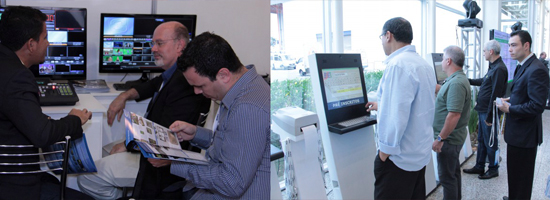
Stay tuned in those numbers:
Conference: August 29 until September 1, 2016:
Trade Show: 12 noon until 8 pm;
Conferences: 9 am until 8 pm;
Expo Center is located in José Bernardo Pinto street, 333 - Vila Guilherme, São Paulo – SP.
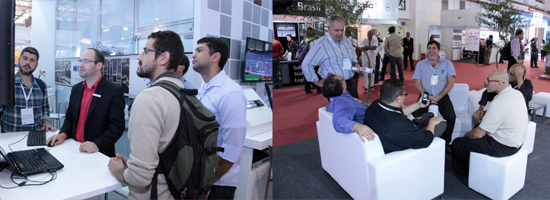
In this video you can view some of SET Expo 2016:
We would like to thank Marcel Almeida for writing for us.
More info you can find on his LinkedIn: br.linkedin.com/in/marcelmg77/en or follow him on Twitter @marcelmg77
Like us if you want on Facebook, follow us on Twitter and Subscribe to our YouTube channel.
mentioned:
SET EXPO 2016 : Website - facebook - Twitter - YouTube
SET : Website
Expo & Conference - ABTA 2016
Expo & Conference - ABTA 2016
One of the most traditional events on pay TV and digital services in Latin America will took place this month in São Paulo at Transamerica Expo Center, from 29 June to 1st July, the ABTA Expo & Conference 2016.

In the year of the Olympic Games in Brazil, ABTA completes 24 years bringing innovations in pay-TV, broadband and media market, focusing on innovation in video services, new technologies, on-demand content distribution platforms such as IPTV and OTT, advertising, satellites, TI, and distribution of linear, non-linear and high-definition content. The Conference will had presentations and panel sessions by highly qualified speakers with professionals from channels, ad agencies, operators, regulators and government. The immersion in technology and management trends will be available in Pay-TV Seminars (STAs), also training seminars with presentations of case studies and market solutions, that is essential to know what is new about technologies and pay-TV tools.
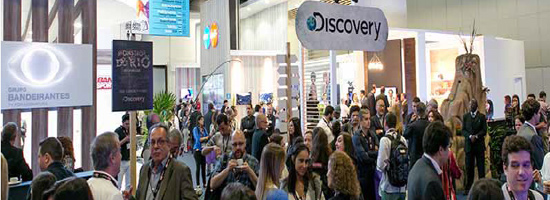
The issues to be addressed in the STAs are: The new consumer of video, DOCSIS 3.1, Advances in multiplatform delivery, The new generation of headends, Sincab, The Internet of Things (IoT), Technology that makes new business models possible, User interfaces for set-top boxes, The road to delivery of content on multiple platforms, How pay TV will develop in the next five years, CxOs and The evolution of pay-TV services.
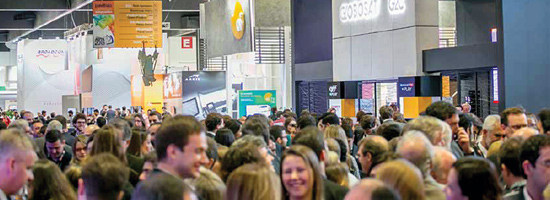
In the Conference program, we have in strategic panels: The reality of the industry and the policy/regulatory outlook, Pay TV in a year of Olympics and challenges, From set-top to cell phone: how pay TV services evolve, Advertising and the Olympic Year, The value of digital services to consumers. In Thematic Sessions we have: The Internet: from the reality of services to regulatory models, User experience and digital services, Audiovisual regulation: from SeAC to VOD, Tackling digital clandestinity, The importance of sports programming to pay TV, Programming in the age of ultrasegmentation, Advertising: consolidation and the role of pay TV, Embracing the reality of on-demand content, Why local production is flourishing, What has happened to C class consumers?, From TV to 4play: the evolution of bundles and offerings and Growing in turbulent times.
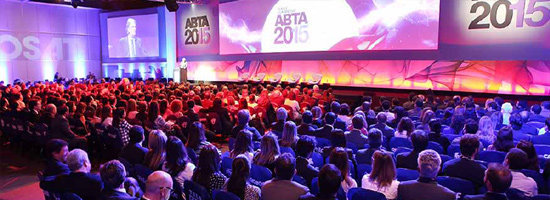
Local and international exhibitors did showcase their brands and developed new business leads in an exhibition space of 9000 square meters.
video:
We would like to thank Marcel Almeida for writing for us.
More info you can find on his LinkedIn: br.linkedin.com/in/marcelmg77/en or follow him on Twitter @marcelmg77
Like us if you want on Facebook, follow us on Twitter and Subscribe to our YouTube channel.
mentioned:
ABTA 2016 : Website - YouTube
IBC 2015 : Time for a short recap
We visited IBC in Amsterdam this year again. Time for a short recap
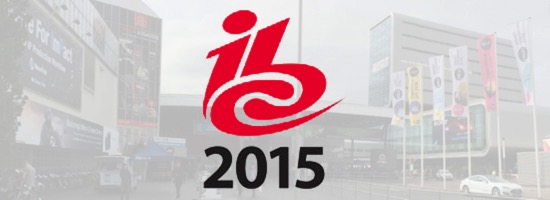
Broadcast Brazil has been visiting the IBC 2015 in Amsterdam. Time for a short recap. Every year the IBC in Amsterdam is for sure in our agenda. The exhibition is just huge, complete and……. huge :) To write down al we have seen and touched will be impossible. We hope you followed the IBC news on our Facebook and Twitter Social channels for most actual news but we have some things that popped out for us this year. We also attended 2 events that were organised near the RAI building where IBC is held, we went to SOHO Editors Final Cut Pro Seminars and the Supermeet.
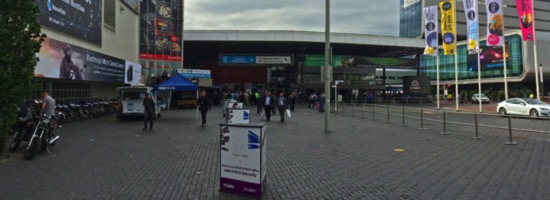
HDR:
In general 4K is now a standard for most new products. So it’s no longer a novelty at IBC 2015. Something that attracted our attention was HDR video. Especially talks about HDR where to be found all over the IBC.
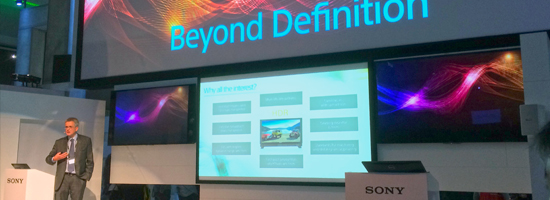
Sony explained the benefits of this technology. HDR will give a highly increased dynamic range. Meaning blacker blacks and brighter whites. Also an enormous colour range increase is possible.
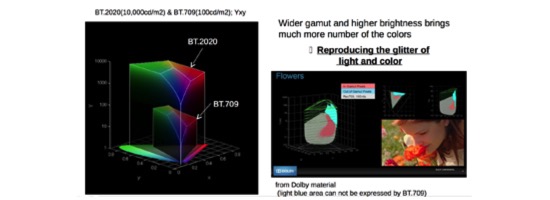
Mobile video transmission:
Mobile Viewpoint introduced their new compact Agile 2R 3G/4G transmitter with audio-return. Very compact, mountable on the back of a camera or in a separate backpack.
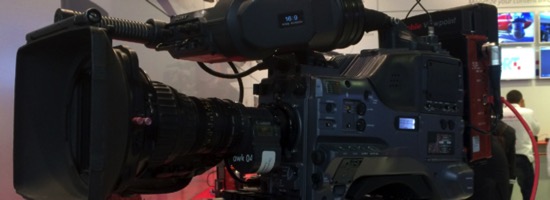
The Mobile Viewpont WMT’s (Wireless Multiplex Terminals) have bee used for a while, and the company keeps improving and their products and expanding their product range. Basically it’s a video over GPRS/3G/4G encoder and transmitter that combines up to 8 sim-cards to create bandwidth.
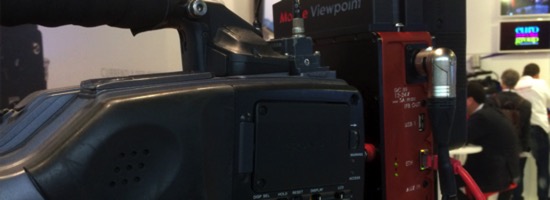
A receiver is connected anywhere on internet to a UTP connection and outputs an SDI/HDMI video signal. SD and HD are both possible. Delay can be as low as 0,8s.
SOHO Editors Final Cut Pro Seminars
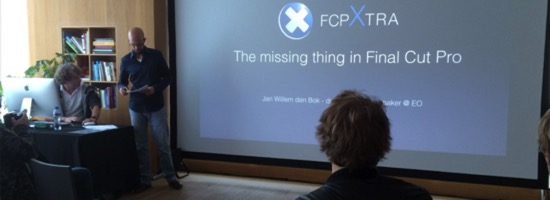
In the Spaces conference rooms at walking distance to the IBC, there were some great seminars with many tips and tricks for editing and Final Cut / Motion workflows, from the people who use FCPX on a daily basis or give trainings in it. What was very good to see, is that Final Cut Pro X, after al it’s updates, can finally be that lightning fast editing environment that many Final Cut Pro 7 editors have been missing. Besides being user-friendly and affordable, you’ll find that when you delve deeper into the tricks and shortcuts, you’ll see that you can put together edits amazingly quickly! We’ll be at SOHO events again in the future! As soon as it is available we will add the video in this article!
Supermeet
The annual Amsterdam Supermeet was again a great event. Most known for it’s world famous Raffle! With roughly 70K€ of prizes to win (including 2 Black Magic camera’s and 4K swithers)
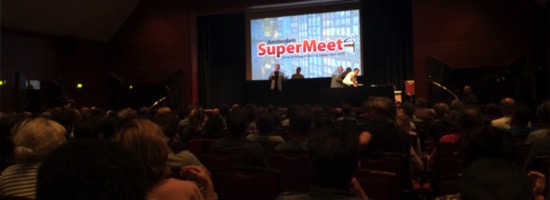
Besides presentations of several key players in video and postproduction, the main speaker was 3x Academy Award winning film and sound editor Walter Murch. Known for The Godfather 2 and 3 and Apocalypse Now. He changed a lot from analog editing, to Avid, to Final Cut Pro, to Premiere and back... for different films. And he likes extensive audio editing within the Final Cut timeline :)
Walter Murch is now 72 years old, and went through all the changes in the industry especially the change from analogue to digital. This guru/veteran decided to connect a huge letter L to his desk, because it signifies the fact that you're always learning.
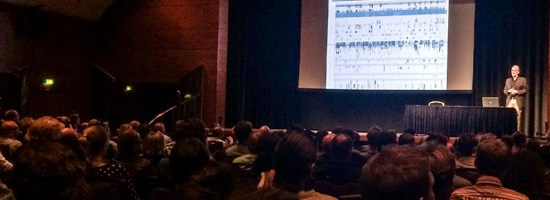
Also be emphasised the importance for him to work standing up, instead of sitting down. Standing while you're editing gives a greater sense of activity and concentration.
Try it out!
We did not find his presentation at the official Supermeet YouTube channel, but somebody did record it.
Video part 1:
Video part 2:
Like us if you want on Facebook, follow us on Twitter and Subscribe to our YouTube channel.
mentioned:
IBC : Website - Facebook - Twitter - YouTube
Sony : Website - Facebook - Twitter
Mobile Viewpoint : Website - Facebook - Twitter
SOHO editors : Website - Facebook - Twitter
Supermeet : Website - Facebook - YouTube
Expo & Conference - ABTA 2015

The ABTA 2015 takes place in a year that promises many challenges for the sector. The growth levels that Brazil, as a country and also in the broadcasting sector, experienced in previous years might not be shown this year, but there is a lot of development going on. At the same time, Brazil continues to receive investments of, for example, cable operators that are implementing new networks, and launching new satellites for Direct To Home (DTH) content delivery. On the programming front Brazil sees several launches of international and national channels, that will have to compete for space at the broadcasters. New companies are aiming at the national market, such as AT&T, with the acquisition of SKY's parent company, and Dish, which still has plans in Brazil.
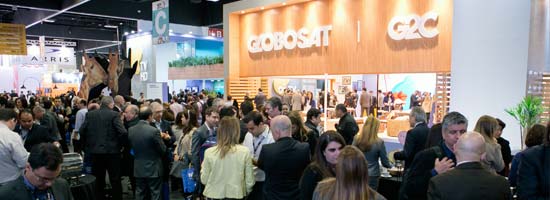
ABTA will take place in the Transamérica Expo Center in São Paulo (SP), on August 4, 5 and 6 , 2015. At the ABTA Conference, there will be debates on the future of pay TV, focusing on innovation in video services. Highlights at the event, will be technology showcases and content distribution solutions such as video on demand, IPTV and over-the-top platforms (OTT), as well as advertising, satellites and IT, and the innovations in linear and high-definition content distribution. Besides that, there are technologies and business in the field of video on-demand platforms, cloud DVR, new user interfaces and innovations in IT and access control.
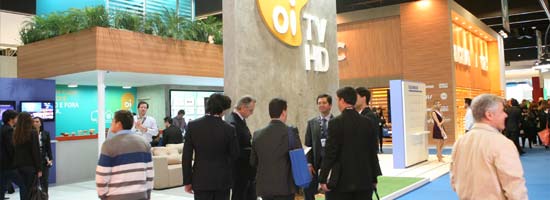
This year, there will be a large exhibition space with more than 100 exhibitors from Brazil and the rest of the world, using the opportunity to showcase brands and leverage new business opportunities. Last year, some of the exhibitors were:
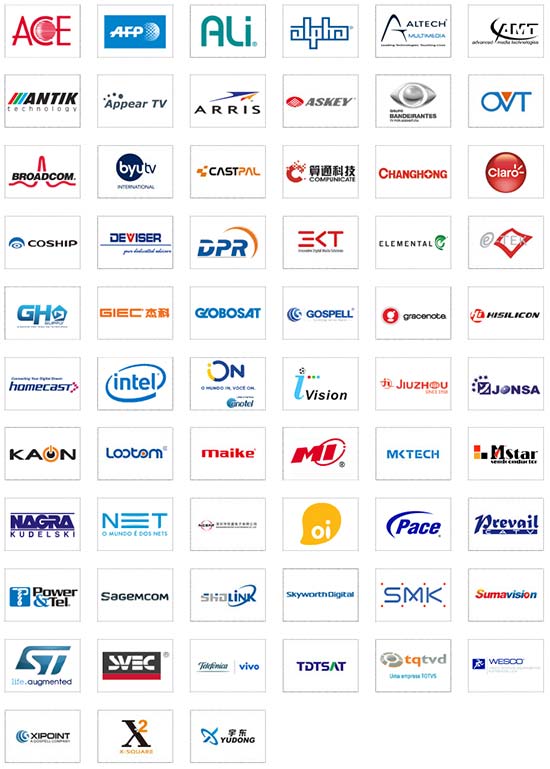
During the conference there will also be panels and discussions on markets, regulation, new technologies and trends, with the participation of executives and key representatives of industry and government. There will also be Pay TV Seminars (STA) with case studies and market solutions.
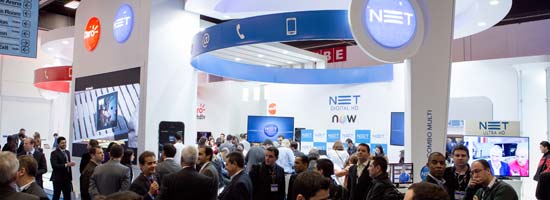
ABTA Expo & Conference has this year the following program:
Tuesday, Aug. 4:
PANEL 1: Sectoral policies and current challenges.
With the sessions: The present and future of the pay-TV market; Free-to-air channels: what changes with digital; The challenges of regulation in the non-linear world; Consumer rights, RGC and service quality; Rights, IP and financing in pay-TV programming; Signal theft: approaches and results
Wednesday, Aug. 5:
PANEL 2: Programming and regulation: results and adjustments;
PANEL 3: Pay TV, the media market and the future of advertising.
With the sessions: The performance of audiences and channels; New formats for advertising; Economic scenarios and growth: where the industry is heading; Pay-TV advertising success stories; Churn and customer loyalty: challenges of a competitive scenario; The future of pay-TV advertising
Thursday, Aug. 6:
PANEL 4: Non-linear TV: a concrete reality.
With the sessions: FTTH, satellite and OTT: directions taken by new operators; Lessons of international experiences; Broadband: strategies beyond bundling; Multiplatform programming.
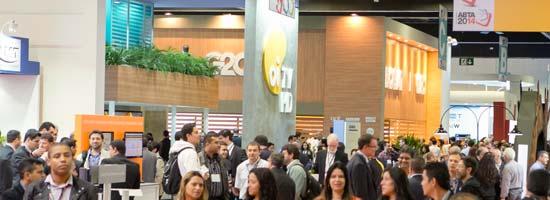
ABTA 2015 is expected about 9.500 people on average in the three-day event, 3.000 more than last year, with more than 10,000 square meters of exhibition space.
Transamérica Expo Center is located close to the city’s main business centers and office districts, and only 12 km from Congonhas Airport, with easy access to Marginal Pinheiros and Av. Washington Luis in Av. Dr. Mário Villas Boas Rodrigues, 387 Santo Amaro – São Paulo – SP – Brazil.
In YouTube Magazine TV channel you can view some of ABTA 2014 and what's to come in 2015.
video:
Info on lectures and more you can find accessing the official website.
We would like to thank Marcel Almeida for writing for us.
More info you can find on his LinkedIn: br.linkedin.com/in/marcelmg77/en or follow him on Twitter @marcelmg77
Like us if you want on Facebook, and follow us on Twitter and Subscribe to our YouTube channel.
mentioned:
ABTA 2015 Magazine TV
PANORAMA AUDIOVISUAL 2015
FAIR AND CONGRESS: PANORAMA AUDIOVISUAL 2015
May 2015 in São Paulo Expo (formerly Centro de Exposição Imigrantes), will occur the biggest event in the Broadcast & Cable segment in Latin America. The previous edition, in 2014, showed growth and maturity of the digital audiovisual market, with over 100 hours of training and more than 90 conferences related to the digital audiovisual industry, with over 1000 participants at the event.
Panorama Audiovisual is aimed at creative professionals, production and distribution of audiovisual content on the platforms like TV, film, radio, broadband, mobile and new media.
Since selecting a tripod for cameras, exhibition systems to transmission, Panorama Audiovisual works to provide qualified information which assist professionals in technical choices and equipments that ensure the best results.
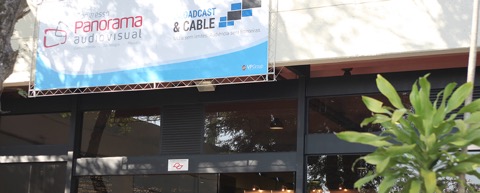
The congress offers reports, dossiers, analysis and interviews brought by professional experience, sucsess stories and reviews of new and basic technologies, with firsthand news.
Panorama Audiovisual is an editorial product of VP Group Integrated Communications, a company based in Alphaville (Barueri/SP, Brazil) and office in Miami (Floria, US) and Madrid (Spain). This structure allows the publishing of magazines and websites - world leaders in the segment, according to Google Analytics - covering Latin America and the Iberian Peninsula.
The president and CEO of VP Group said -- "This finding has encouraged us to expand the scope of the events we do, distributing them throughout the year."
The mission of the congress is discuss technologies and strategies that moves the Brazilian's audio and video market. Since the selection and operation of cameras and editing software to media monetization, every niche of this market will be treated in various discussion sessions, workshops and tutorials of the event this year. "In 2015, we will expand further this debate and the training and professionalisation programs", says Fernando Jay, director of the event.
"Therefore, it is fundamental an event like this, which encourages the professionalism of the entire industry and opens opportunities of updates and training for sector professionals to follow the latest trends of this innovative and dynamic market", says Victor Piiroja, President and CEO of VP Group.
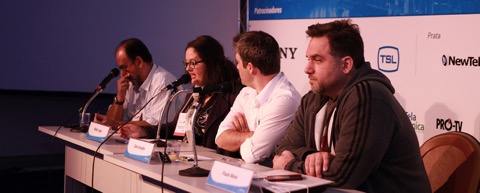
The main themes of the congress, dedicated to professional development and promotion of new technologies, will be solutions for production and distribution of audio and video on TV, film, new media, advertising, animation and games.
Among the topics, the themes are:
• Migration to 4K, H.264 and HEVC;
• Cameras and Lenses for Digital Production;
• Resources for Digital Cinematography;
• Recording in Multiple Codecs and Resolutions;
• Editing and Post-Production Systems;
• Color Correction and VFX;
• Applications for HDR and HFR;
• Automated Production of Journalism and Sports;
• Coverage of Competitions and Shows;
• New Lighting Technologies;
• Generation of Graphics and Virtual Sets;
• Integration with Social Media;
• Storage and Restoration;
• Media Management and Big Data;
• Cloud Based Services;
• TV Everywhere: Multiplatform Distribution, IPTV, VOD and OTT;
• Broadband and Pay TV;
• Infrastructure and Network Planning;
• RF Transmission, Satellite and FO;
• Quality Control and Signals Monitoring;
• Infrastructure for Technical Centers;
• Processing, Conversion and Playout;
• IP Based Production;
• Dispute of the Spectrum and the future of Broadcast;
• Analog Switch-Off and Digital TV Expansion;
• Radio in a scenario of Media Convergence;
• Interference and Wireless Networks;
• Transmedia, Connected TVs, APPs and Second Screen;
• Acoustic and intelligibility;
• Capture and Multichannel Audio Mixing;
• Immersive Audio;
• Loudness Control in Broadcast Ambience;
• Digital Cinema and VPF;
• Digital Projection Technologies;
• Education and Innovation;
• TV Series, Webseries and Interactive Narratives;
• Games and Animations;
• New Sources of Revenue;
• Incentive Laws and Fundraising for Audiovisual.
The existing sectors during Panorama show 2015 will be: Open TV, Pay TV, IPTV, Wireless Media, Radio, and Internet and streaming, Telecommunications, Satellite, Broadcast-cable, Digital Cinema, IT, 3D, Digital Signage, Education and Training
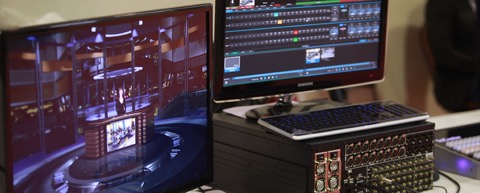
You can watch some videos of what happened in the previous edition:
We would like to thank Marcel Almeida for writing for us.
More info you can find on his LinkedIn: br.linkedin.com/in/marcelmg77/en or follow him on Twitter @marcelmg77
So we hope this is, besides, fun to read, also a good help and insight information about broadcast events held in Brazil and what the future may hold.
Like us if you want on Facebook, and follow us on Twitter
mentioned:
Video News Ocean Journey The Oosterschelde
Video News Ocean Journey The Oosterschelde
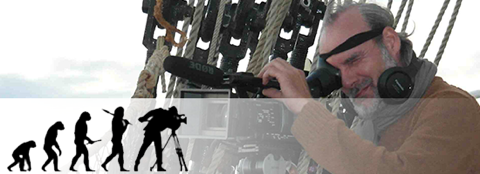
Route Brazil - South Africa 1st of April 2013 - May 2nd, 2013
Assignment: a video journal of a long ocean voyage about the life and atmosphere on board for six weeks . A Dutch three-masted tallship
The Oosterschelde from 1918 on a world trip along continents and historical VOC routes, from Rotterdam to Rotterdam.
After 26 years a former classmate from the Academy of Journalism nosed out that I, as journalist-filmmaker, live in Brazil and submitted me the following challenge ...
For a 13-episode documentary series for Dutch television we are looking for an adventurous director-videographer who can film independently, interview and edit on board. “You will do it for the adventure, because budget is tight, but expenses are paid and we will feed and accommodate you onboard”.
Well... a typical once-in-a-lifetime opportunity... crossing the Atlantic on an old Dutch schooner …. ?
A quick look at my calendar for the next few months , a few phone calls to my customers with long-term film projects ... and the decision came in an instant wink .. I grab my suitcase and prepare my camera kit !
Santos (BR) - Cape Town (SA)
This ocean voyage is known as one of the longest and hardest routes that the Oosterschelde carries on this world of 1,5 years. The route takes from the subtropical waters of Santos towards South Africa’s Cape Town, around the Cape of Good Hope. During this long crossing the authentic Dutch three-master must stand various challenges, the conjunction of two trade – currents; the tropical trade wind meets cold trade from Antarctica on the 35th and 40th parallel .. and that guarantees fierce storms and high waves, and all at an ocean depth of 5 kilometres.
Total distance of up to 3,500 miles, or 6,880 kilometres. This requires a strong western wind which should bring the three-master towards its eastern destination. But to find it, one must navigate to get there.
But before Cape Town will be reached, a secure check of the list needs to be done of what to bring. For more than a month at sea with full gear , you cannot afford to forget that one charger or cable!
Check... Enough batteries, rain gear for the camera , lens cleaner for the inevitable salt deposits, sufficient terrabites on the backup disks, since I will be shooting each day and everything in full HD.
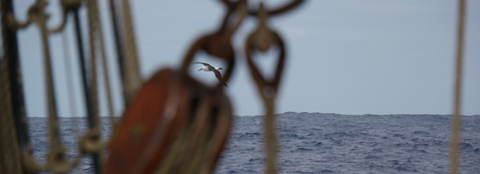
STORM
Just 50 kilometres off the coast of Santos, I already get my pick, force 9, rising to 10 Bft ... and that means storm!
Not knowing how often we were going to go through such a hell , I film just to be sure ... at least, as much as possible to maintain your standing and to avoid the big waterspouts across the deck. Filming on board a sailing ship
under those circumstances, staring through your viewfinder, provides a different perception of the reality around you. And that's tricky. Everything that is not fixed on lower and upper deck, thunders from baking to starboard.
And that goes for me as well, because ‘man overboard' really means overboard, and no one who can save you.
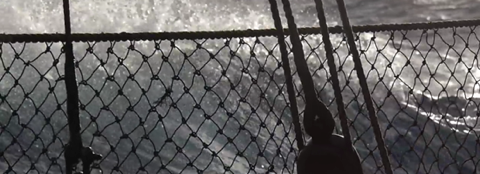
MOST REMOTE ISLAND IN THE WORLD
Highlight of the trip; halfway through the journey is the world's most remote island of Tristan da Cunha. With 2,265 miles on the map a stopover is scheduled here. The volcanic mountain in the middle of nowhere measures only 15 square kilometres and 2,060 meters high, counts just 260 inhabitants in almost complete isolation.
This colonial island that was discovered by the Portuguese in 1505 but eventually annexed two centuries later by the British. The island has a reputation of a ship graveyard, because the almost impassable coast and waves here over the centuries costs a lot of shipwrecks . If I succeed to go ashore, I 'm going to get a stamp in my passport first.
LAND IN SIGHT
After 15 days at open sea .. finally .. land in sight. It would be strange to feel land underneath your feet again. But unfortunately .. our party is negated by the local authorities of Tristan. The weather is not cooperating. It's too dangerous to dock at the island. So after a full day and night to float around in the hope that it would clear again around, we finally set sail for Cape Town . Disappointment among the guests and crew, but for me moments again for nice shots and quotes for the script.
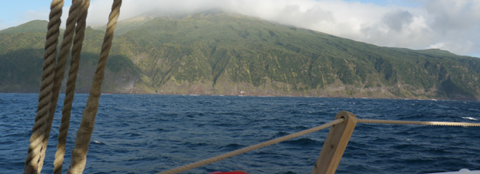
Standing up editing
At the end of the day when people are asleep or on a watch, I upload my footage to the backup. My cabin is not big enough for a small editing set installation, so sometimes you stand in front of your marine cage or improvise a quiet spot below deck to spot and assemble an edit timeline.
The days that follow to Cape Town under favourable weather conditions I interviewed the 12-member guest and 6 crew. Interesting to hear from each about his or her background for this project and their passion for ocean sailing.
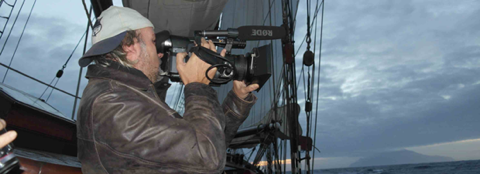
KILL YOUR DARLINGS
After more than a month, at a beautiful dawn we see the first outlines of the South African coast… Cape Town... we made it! The storms that would follow repeatedly during the trip, I and my gear overcome.
For the upcoming 15-minute episode I have more than enough terra bites of shots. So now up to the final montage and 'Kill your Darlings ...’
Filmmaker – director Ernst Daniel Nijboer
Visuals Studio Brazil
video:
mentioned:
Visuals Studio Brazil
TallShip de Oosterschelde
Tristan da Cunha
Authorization for Filming in Brazil
Authorisation for Filming in Brazil
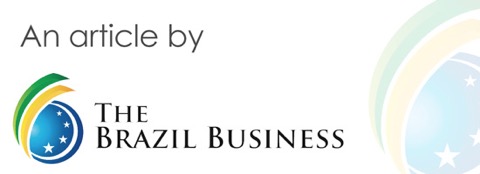
Foreign companies that want to film in Brazil need special documentation to do so legally. Read the article to learn what documentations are needs to be provided to act within the law when filming.
Foreigners who intend to make news reports, films, recordings or capture moving images in Brazil (with or without sound) have to previously ask for ANCINE's authorisation. ANCINE is short for Agência Nacional de Cinema, the national movies agency that is responsible for inter-mediating at the Brazilian diplomatic missions abroad, the requests for proper visa concession for technicians and artists, so they can participate in filming in the country.
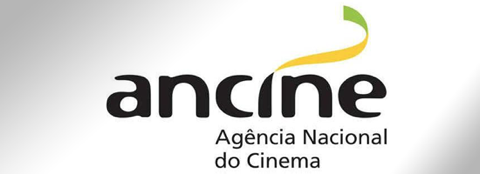
How to Request Authorisation
Apart from foreign journalistic productions, all of the others have to contact a Brazilian production company that will make contact with ANCINE. First, the Brazilian company communicates with ANCINE about its interest and responsibility in making the films or recordings, through a form available in this link. It’s also necessary to present the following documentation:
• Copy of the contract between the foreign production company or person that is legally responsible for the production, and the Brazilian production company, and should indicate the mutual responsibilities, form of payment and the expiration date of the contract.
• Copy of the translated contract mentioned, if it was written in a foreign language.
• Provisional plan of filming/recording, indicating the dates and the places (Municipality/Federal Unit) in the Brazilian territory where the works will happen.
• Copy of the identification sheets of the passport of each one of the foreign workers.

The Brazilian company will be the one responsible for making the customs clearance of all the temporary material used for the production, giving full support to the foreign company.
Any alterations in the originally established conditions have to be reported to ANCINE through a form available in this link. It’s also necessary to present the following documentation:
• Change in the Brazilian diplomatic mission to which the visa request is destined.
• Inclusion or exclusion of technicians and artists.
• Deferral/alteration in the temporary stay term of the technicians and artists in the country.
• Change in the places where the filming/recording will take place.
• Cancellation of the authorised activity.
The visa is issued abroad, on the Brazilian diplomatic missions, once ANCINE approves the concession of visa and provisional stay in the country.
The validity of the visa is determined by the mission, according to the length duration of the filming/recording chronogram.
It may also be necessary to ask for an authorization from CET, the Companhia de Engenharia de Tráfego, which is the Traffic Engineering Department, in case the filming is happening in some street. There are different authorisations in this case, whose prices vary from BRL 148.95 to BRL 1,747.45. The complete table of services is available in Portuguese, here, under the title “Filmagem, fotografia, produção de audiovisuais e similares”, which is filming, photography, audiovisual production and similar.
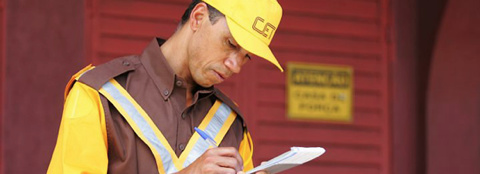
Some cities may have specific forms which must be filled in order to provide the authorization for filming, which must be checked at the City Halls.
Journalistic Productions
The production of foreign audiovisual journalistic works have to be communicated straight to the Brazilian diplomatic missions abroad, so that the proper authorisations can be issued. In these cases, the people going to Brazil to work can apply for a temporary visa as foreign newspaper, radio, television or agency correspondents. There may be internal demands, for instance, a special authorisation to film in a hospital, but these are local specifications, not migratory ones, and need to be checked in the specific places where the filming will occur.
A big thank you goes to our friends at The Brazil Business who were so kind letting us use this very informative post.
Be sure to check the Broadcast Brazil Facebook page and LIKE us.
Lot's of news, photo's and info for broadcasters, webcasters and mobile producers in Brazil.
Brazilian Cinema and International Events
Brazilian Cinema and International Events
Most of the foreigners might have never heard from ANCINE, well that is not that strange since it is the government institution for Cinema.
For 2014 this institution applied new rules in terms of promoting and stimulating national cinema outside of Brazil, which is great!

Here some more information about the publication made by ANCINA
"ANCINE publishes rules to support the participation of films, projects and professional programs in international events in 2014.
This Program supporting festivals shall also include projects in workshops.
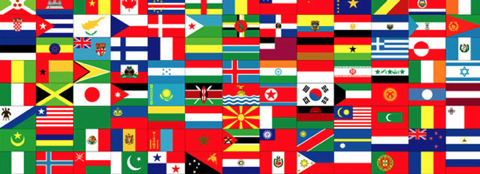
Aiming to encourage the promotion of Brazilian audiovisual production abroad and increase the participation of Brazilian companies abroad in the audiovisual market ANCINE renewed it's program for the year 2014, with two support programs aimed at the international area.
These programs seek to contribute and facilitate the participation of national films and projects at major festivals and workshops of the international cinema, besides also the participation of the sector in market related events and business meetings.
"We believe that the format they will implement this year, through the extension of both programs will allow a more comprehensive role in enabling the presence of Brazilian companies and professionals in major international events in the audiovisual sector. There is a complementarity between the three lines that make up the programs because they make us understand the development and presentation on one hand, and the negotiations in order to produce and make the product move in the international market, "said Rosana Alcantara, director ANCINE.
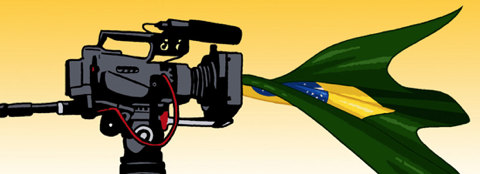
The Support Program Participation of Brazilian Movies at International Festivals, launched in 2006 by ANCINE, assists with financial services and resources, depending on the event, for the participation of short, medium and Brazilian feature films selected for festivals abroad. Starting this year, the program shall also include financial support for selected projects for international workshops
The International Advisor for ANCINE, Eduardo Valente, justifies the inclusion of laboratories/workshops in the program with the assessment that "these events today have outstanding importance in the international projection of work and increasingly curators go to these events to invest in these works. With this increase, the total number of events in the program reaches 107, throughout the year."
This way we see that the audiovisual market is not only expanding one way, which is mostly foreigners coming into Brazil, but that we can expect the coming years a rise of Brazilian products and professionals appearing in the foreign markets as well.

Great news, because this will stimulate the international market for Brazil and in the coming years prepare the Brazilian audiovisuals even better for the Olympics.
On this site you can read more about the program, it is in Portuguese but Google Translate will help out pretty well ;-)
Mentioned:
ANCINE

